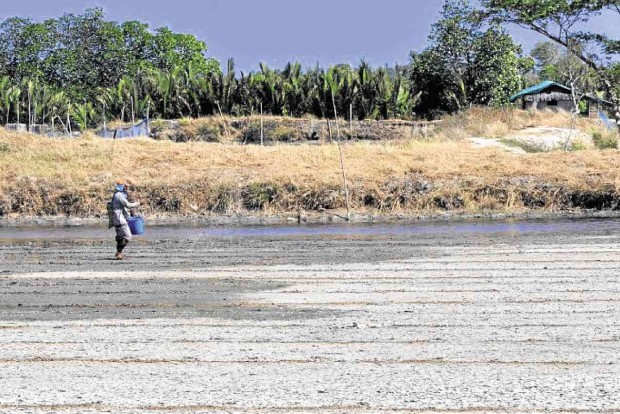Fish growers lose as Pangasinan ponds dry up

A FISHPOND worker surveys a pond that has been drying up due to the intense heat in Barangay Dulig in Labrador town in Pangasinan province. WILLIE LOMIBAO / Inquirer Northern Luzon
DAGUPAN CITY—The El Niño phenomenon is now beginning to dry up fish ponds in Pangasinan province, incurring losses to fish farmers, a provincial agriculture official said on Friday.
Since January, the Pangasinan government has been receiving reports about ponds drying up in the coastal towns because of the intense heat, said Dalisay Moya, provincial agriculturist.
“Most ponds, especially those dependent on rivers, have been affected [by El Niño] in Pangasinan,” said Moya in a television interview.
Westly Rosario, chief of the National Integrated Fisheries Technology Development Center here, said freshwater aquaculture enterprises, such as tilapia farming, are most vulnerable to El Niño.
“But in brackish water, there is tidal fluctuation and so there is no problem because the level of water is the same,” said Rosario.
Article continues after this advertisementBrackish water, a combination of salt water and freshwater, is located in areas where the river meets the sea.
Article continues after this advertisementBut Rosario said some fish farms, which were built using outdated engineering designs, still suffer because the pond water is not completely flushed out during tidal fluctuations.
“These are the ponds that are 5 to 10 hectares wide. Aside from the very wide area, they also have small floodway gates. So, not much water is flushed out during low tide and during high tides. A few amounts of water are retained,” he said.
As a result, he said, the pond water becomes salty, killing the freshwater fish stocks in the pond.
“We can see this in many areas in Bani [town], where the water salinity is [measured at] 40 parts per thousand (ppt),” Rosario said. The normal sea water salinity is 35 ppt.
Bani, a coastal town in western Pangasinan, is crisscrossed by several rivers that exit toward the Lingayen Gulf. The Tambac Bay, which Bani shares with neighboring Bolinao town, is the source of water of the Pacific Farms, the country’s leading salt producer.
In places where the river system is good, there should be no problem, Rosario said.
The province’s thriving “bangus” (milkfish) will not be affected by El Niño because bangus can be raised in both freshwater and salt water, he said.
He said hot temperatures make bangus productive because the stress induced by warm weather leads them to spawn.
“Beyond 40 degrees Celsius, there could be physiological problems [for bangus], especially when the pond is shallow. But if the pond is deep, the fish can always dive to the bottom,” Rosario said.
Under its comprehensive national fisheries industry development program, the Bureau of Fisheries and Aquatic Resources will build 40 satellite hatcheries for a tilapia species that can be raised in a saline environment.
“This is the Tilapia molobicus, which we developed about 15 years ago,” Rosario said. Gabriel Cardinoza, Inquirer Northern Luzon